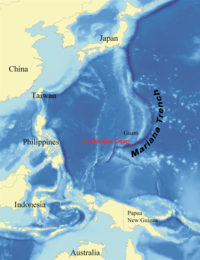
Photo from wikipedia
Hadal ocean sediments, found at sites deeper than 6,000 m water depth, are thought to contain microbial communities distinct from those at shallower depths due to high hydrostatic pressures and… Click to show full abstract
Hadal ocean sediments, found at sites deeper than 6,000 m water depth, are thought to contain microbial communities distinct from those at shallower depths due to high hydrostatic pressures and higher abundances of organic matter. These communities may also differ from one other as a result of geographical isolation. Here we compare microbial community composition in surficial sediments of two hadal environments—the Mariana and Kermadec trenches—to evaluate microbial biogeography at hadal depths. Sediment microbial consortia were distinct between trenches, with higher relative sequence abundances of taxa previously correlated with organic matter degradation present in the Kermadec Trench. In contrast, the Mariana Trench, and deeper sediments in both trenches, were enriched in taxa predicted to break down recalcitrant material and contained other uncharacterized lineages. At the 97% similarity level, sequence-abundant taxa were not trench-specific and were related to those found in other hadal and abyssal habitats, indicating potential connectivity between geographically isolated sediments. Despite the diversity of microorganisms identified using culture-independent techniques, most isolates obtained under in situ pressures were related to previously identified piezophiles. Members related to these same taxa also became dominant community members when native sediments were incubated under static, long-term, unamended high-pressure conditions. Our results support the hypothesis that there is connectivity between sediment microbial populations inhabiting the Mariana and Kermadec trenches while showing that both whole communities and specific microbial lineages vary between trench of collection and sediment horizon depth. This in situ biodiversity is largely missed when incubating samples within pressure vessels and highlights the need for revised protocols for high-pressure incubations.
Journal Title: Frontiers in Microbiology
Year Published: 2019
Link to full text (if available)
Share on Social Media: Sign Up to like & get
recommendations!